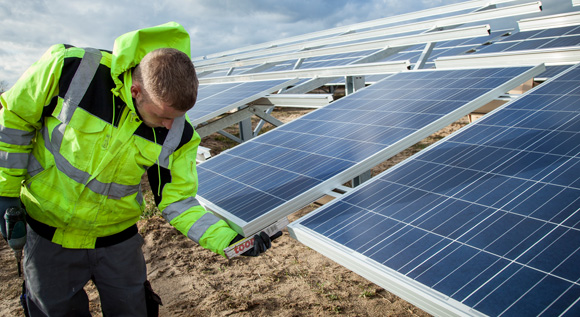Unearthing the treasure in old solar modules
Twenty-five years down the line, photovoltaics modules have generally come to the end of their service life. The raw materials then contain are still valuable, but most of the components still end up in the rubbish. A research project funded by the Federal Ministry for Economic Affairs and Energy aims to change this.
 © Holger Vonderlind
© Holger Vonderlind
Across Europe, around eight million photovoltaics modules are currently in use, converting energy from the sun into electricity. These modules are full of valuable raw materials like copper, silver, tin, aluminium, not to mention glass of silicon. But what happens when the PV modules have been in use for around 25 years and have come to the end of their service life? The glass and the aluminium frame are parts that are often reused, but other components that have spent their time on house roofs or as ground-mounted installations inevitably end up on waste disposal.
The goal: to recycle silicon and silver as well
The scientists and companies involved in the ‘End of lifestyle in PV modules’ (EoL-Cycle) research project are looking to change current practice. They are working to develop and test different sorting and cleaning procedures which are to be used to recover raw materials such as copper, silver, silicon and tin. The enhanced sorting methods will also improve the purity of the glass and will help reduce the level of dust and particulate matter. EoL-Cycle is being funded by the Federal Ministry for Economic Affairs and Energy, which is providing around €1.7 million for the project over four years.
Thousands of tons of old modules over the next few years
The pressure is on for the development of new recycling procedures to be completed as, over the coming years, the number of modules that will reach the end of their service lives is set to vastly increase. According to estimates by the bifa environmental institute, there will be around 10,000 tons of old modules produced in Europe in 2018, by 2022, the yearly figure will have risen to a massive 100,000 tons and is only set to increase. German legislators have already responded to this situation. Since 1 February 2016, the new “Electrics Law”, as it is known, now also applies to PV modules. The legislation marks the first time that rules on take-back and disposal have been enshrined in law. Owners of old installations can now give household quantities of old installations back to the manufacturer or can load them off at over 1,700 public collection points all over Germany, both free of charge.

